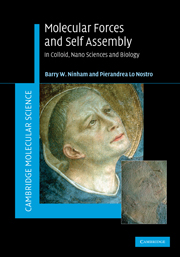Book contents
- Frontmatter
- Contents
- Preface
- Part I Molecular forces
- 1 Reasons for the enquiry
- 2 Different approaches to, and different kinds of, molecular forces
- 3 Electrostatic forces in electrolytes in outline
- 4 The balance of forces
- 5 Quantum mechanical forces in condensed media
- 6 The extension of the Lifshitz theory to include electrolytes and Hofmeister effects
- 7 Specific ion effects
- 8 Effects of dissolved gas and other solutes on hydrophobic interactions
- Part II Self assembly
- Index
- References
1 - Reasons for the enquiry
from Part I - Molecular forces
Published online by Cambridge University Press: 06 January 2011
- Frontmatter
- Contents
- Preface
- Part I Molecular forces
- 1 Reasons for the enquiry
- 2 Different approaches to, and different kinds of, molecular forces
- 3 Electrostatic forces in electrolytes in outline
- 4 The balance of forces
- 5 Quantum mechanical forces in condensed media
- 6 The extension of the Lifshitz theory to include electrolytes and Hofmeister effects
- 7 Specific ion effects
- 8 Effects of dissolved gas and other solutes on hydrophobic interactions
- Part II Self assembly
- Index
- References
Summary
Molecular forces: some of the background and history of ideas. Why molecular forces?
The matter that concerns us was most clearly articulated nearly a century ago by D'Arcy Thompson in his famous book. He reported the pleas of the early founders of the cell theory, of the then biology, and of the physiologists, that chemists should address the question of molecular forces, then unknown.
We would like to know how it is that molecular forces and the laws of statistical mechanics conspire, with the geometry of molecules and the conformations available to macromolecules, to give rise to the hierarchies of self-assembled equilibrium or dynamic steady states of matter that form cells and dictate biochemical reactivity.
In other words, the game is to link structure and function, the geometry of assemblies of molecules, to the forces that drive self assembly and recognition processes. Any insights ought to allow us to build better, useful connections between the physical and biological sciences. Despite tantalizing hints, that main aim has remained elusive.
D'Arcy Thompson tells us too that of the chemistry of his day and age, Kant said that ‘it was wisschenschaft, nicht Wissenschaft; in that the criterion of a true science lay in its reliance on mathematics’. Kant believed that Euclid's geometry was self-evidently that of nature. We now know better. Hyperbolic geometries that we shall come to later better describe the bicontinuous, random honeycombs of nature.
- Type
- Chapter
- Information
- Molecular Forces and Self AssemblyIn Colloid, Nano Sciences and Biology, pp. 3 - 16Publisher: Cambridge University PressPrint publication year: 2010

